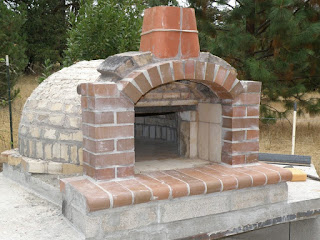In many ways, it was a good thing that I needed insulation over my oven build...didn’t want someone wandering by that knew about brickwork...or more importantly point out how much I still didn’t know about laying brick. Creating an insulation coat of perlcrete over the entire oven sounded pretty easy at the time (and a great way to hide/bury the evidence of my shortcomings as a brick layer). As with all my projects, once again, I was able to make the job more difficult than it needed to be.
I decided that in order to make a consistent thickness of perlcrete over the oven dome, it would be a good idea to use wire mesh placed over the dome at a set distance. When I laid on the perlcrete, I could keep the thickness of the insulating layer fairly even just by keeping the wire in the center of the layer. Subsequent methods by Gulf & UtahBeehiver (Forno Bravo forum) would have been much better, but this worked for me at the time.
First, I built quite humorous (and flimsy) forms around the oven perimeter using bricks and wood scraps. I poured a 3-4 inch thick layer of standard redi-mix concrete a minimum of 4" out from the oven base and then embedded wire mesh into the concrete. When the concrete set, I cut, shaped, formed, and secured the wire over the dome. I was pretty happy that this wire mesh would give me a good thickness guide and add some strength to the insulation cap. Into the concrete I also embedded a leaning piece of ½" rebar on each of the front opening sides to add a little more buttressing strength for the front arches.
What a pain! The perlcrete does not want to “stack” up the sides of the dome. Some will hold behind the wire, but mostly I put it in place and it falls out of place. In addition, I had read that putting a layer of diatomaceous earth (DE) between the dome bricks and insulation layer would help provide expansion slip (as the dome expanded and contracted during firing/cooling cycles) and actually fill minor cracks in the dome mortar joints. However, that DE layer also kept the perlcrete from adhering in any way to the oven bricks...bummer! I also could not get the 10:1 perlcrete mix to hold, so I backed off and ended up using a 6:1 or 7:1 mix that at least I could work with...just a little frustrating!
Decided that it was really just the vertical, lower half portion of the oven that was the problem...so...leftover plywood to the rescue. I set pieces vertically along the base of the oven and then I could simply drop the perlcrete into the space between them and the sides of the oven. The wire mesh didn’t seem to impede the perlcrete as it was dropped down and the loose insulating perlcrete mix appeared to encase the wire nicely as it filled the gap. Once I got to the portion of the oven where it started to “dome” significantly, the perlcrete finally would stay in place. With this technique, insulating the oven dome went quite a bit faster...until of course we ran out of perlite and were due to head out on a trip.
Oh well...I set up a canopy again to keep the rain off and figured the perlcrete would just dry and cure until we got back from our trip...but right now, I need a beer!









































